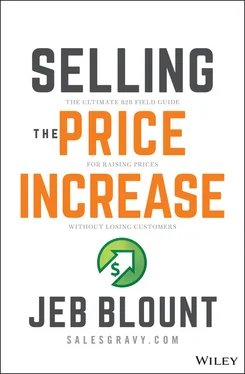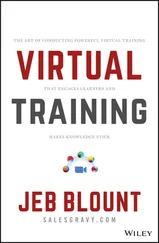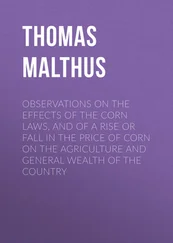Jeb Blount - Selling the Price Increase
Здесь есть возможность читать онлайн «Jeb Blount - Selling the Price Increase» — ознакомительный отрывок электронной книги совершенно бесплатно, а после прочтения отрывка купить полную версию. В некоторых случаях можно слушать аудио, скачать через торрент в формате fb2 и присутствует краткое содержание. Жанр: marketing, на английском языке. Описание произведения, (предисловие) а так же отзывы посетителей доступны на портале библиотеки ЛибКат.
- Название:Selling the Price Increase
- Автор:
- Жанр:
- Год:неизвестен
- ISBN:нет данных
- Рейтинг книги:5 / 5. Голосов: 1
-
Избранное:Добавить в избранное
- Отзывы:
-
Ваша оценка:
- 100
- 1
- 2
- 3
- 4
- 5
Selling the Price Increase: краткое содержание, описание и аннотация
Предлагаем к чтению аннотацию, описание, краткое содержание или предисловие (зависит от того, что написал сам автор книги «Selling the Price Increase»). Если вы не нашли необходимую информацию о книге — напишите в комментариях, мы постараемся отыскать её.
Selling the Price Increase: The Ultimate B2B Field Guide for Raising Prices Without Losing Customers
Selling the Price Increase
broad-based, targeted, non-negotiable, negotiable, defending, presenting,
asking
Virtual Selling
Selling the Price Increase
Selling the Price Increase — читать онлайн ознакомительный отрывок
Ниже представлен текст книги, разбитый по страницам. Система сохранения места последней прочитанной страницы, позволяет с удобством читать онлайн бесплатно книгу «Selling the Price Increase», без необходимости каждый раз заново искать на чём Вы остановились. Поставьте закладку, и сможете в любой момент перейти на страницу, на которой закончили чтение.
Интервал:
Закладка:
I sunk in my seat as he dropped the bomb. We each needed to get a net 6 percent increase from our account base. He asked us to go through the list and choose the accounts to approach for price increases. He gave us until the end of the week.
Back at my office, as I started pouring over my accounts, I became sick to my stomach. I'd worked hard to establish those relationships. Many customers had become friends. Raising their prices felt like a form of betrayal.
As I evaluated each customer, I found good reasons why I shouldn't approach them with a price increase. I went through the list again and again but could only identify a few accounts to go after. I came to the conclusion that it would be impossible to net a 6 percent increase on my customer base.
When I met with my boss at the end of the week, I unloaded all of my excuses. But to no avail. He told me flatly and firmly that our leadership wanted a 6 percent increase and there would be no excuses. I had no choice.
I left that meeting feeling deflated and consumed with fear for how my customers would respond. I almost quit my job over it. Prior to being told I had to sell price increases to my customers, I loved my job. Now, I was questioning everything. I'd rather have done a thousand cold calls from inside a shark tank than approach a single customer with a price increase.
Mostly though, I was afraid. I procrastinated and avoided those conversations until I was forced to get the job done because I was out of time. I made lots of mistakes and fear got the best of me. It was one of the worst periods of my sales career. I made it through that awful ordeal but the lessons I learned about confronting fear stuck with me.
Salespeople Hate Price Increases
Over the years I developed thicker skin and a more effective approach to price increase conversations. But I still don't like to do it. It's one of things I share in common with most sales professionals and account managers – nobody likes price increases.
The truth is that salespeople love close sales, love to give discounts, love to make our customers happy, love to solve problems. But, as a rule, we have a psychological aversion to and loathe selling price increases.
Approaching customers with price increases sits at the tip top of the pantheon of things sales professionals hate. It sits higher than collecting receivables, cold calling, and entering data into the CRM.
Given the choice between selling price increases and doing anything else – and I mean anything – salespeople will always choose anything else. There are many reasons why, including:
Conflict avoidance
Fear of rejection
Desire to be liked by their customers
Awkwardness of communicating price increases
Sympathy for customers
Fear of losing customers, sales, and income
No buy-in to the justification for the price increase
The price increase is not aligned with compensation
Lack of understanding of the impact of price increases on their organization
Price Increases Matter
One of the reasons that I hated price increases and believed that I was betraying my customers is that I didn’t understand basic business fundamentals. I didn’t understand that price increase campaigns are far more effective at generating profit and free cash flow than increasing top-line revenue through sales volume increases or acquiring new customers.
Nothing else in the business-to-business sales arsenal protects the health of your company like price increases. They protect the enterprise during inflationary periods, produce capital for investment in growth, help improve quality and service delivery, boost stock prices, and protect jobs.
The payoff for price increases is massive. They can drop through as much as 400 percent more profit as increases in sales volume. For example, a 1 percent increase in sales volume, will produce 3.3 percent in profit. However, a 1 percent increase in price, when sales volume remains stable, delivers an 11.1 percent increase in operating profit. 1
The bottom line is that increasing prices is the single greatest profit improvement opportunity and strategy for B2B enterprises. 2 That is, of course, if you retain your customers along the way.
Customer retention is exactly why your company leans so heavily on you to execute price increase campaigns. Sales professionals have the most intimate knowledge of the customer base, are skilled communicators, and professional closers.
Except that, in overwhelming numbers, sales professionals express deep anxiety and lack of confidence with price increase initiatives. They fear that they will lose customers and permanently damage important relationships. They feel that they lack the skills to approach price increase conversations effectively. Compounding this is the fact that most companies provide little to no formal training for selling price increases, even for frontline leaders who must coach this critical skill set.
Without a process, system, or framework for selling price increases and handling subsequent objections, sellers usually underperform in these crucial conversations. Price increase initiatives then become little more than anxiety filled distractions that negatively impact overall sales performance. It’s no wonder that upwards of 70 percent of leaders express little confidence in their sales teams’ ability to execute price increase conversations effectively. 3
Types of Price Increase Initiatives
In this book, we'll address the most common B2B price increase scenarios for which you will be responsible.
Broad-Based Price Increase Campaigns
Broad-based campaigns are executed at the enterprise, divisional, or regional level and impact many customers at the same time. They typically require the entire sales and service team to engage.
Targeted, Account-Based Price Increases
These initiatives target specific accounts at contract renewal, on reorders, or for specific line items. Targeted price increases are usually leveraged to improve the profitability of specific accounts and to optimize pricing that was set too low when the customer was acquired.
Non-negotiable
With non-negotiable price increases, your organization has calculated that the reward of implementing the price increase is high while the risk of losing customers is low. Marketing will usually take the lead with messaging and notifying customers of the impending increase. Sales and customer service will primarily be responsible for answering customer questions, calming dissatisfaction, and defending the price increase.
Non-negotiable with Exceptions
In some cases, non-negotiable price increases may be administered with exceptions for certain classes of customers like new accounts, strategic accounts, accounts that are in jeopardy due to service issues, and angry customers who push back hard.
The sales and service teams will be responsible for identifying the accounts marked for exceptions and communicating the reasons behind the exceptions to the management team. Your primary role will be to defend the price increases when confronted by upset customers so that the increases stick.
Negotiable
With larger accounts, bigger price increases, complexity, risk, and competitive pressure comes the need to negotiate with customers that push back. This is where talented sales professionals with knowledge of the accounts and established relationships are needed most.
With negotiable price increases there will be greater emphasis placed on account targeting, pre-planning, messaging, risk management, and business case presentation. Leaders will need to set clear individual goals and objectives and define reasonable negotiating parameters.
Читать дальшеИнтервал:
Закладка:
Похожие книги на «Selling the Price Increase»
Представляем Вашему вниманию похожие книги на «Selling the Price Increase» списком для выбора. Мы отобрали схожую по названию и смыслу литературу в надежде предоставить читателям больше вариантов отыскать новые, интересные, ещё непрочитанные произведения.
Обсуждение, отзывы о книге «Selling the Price Increase» и просто собственные мнения читателей. Оставьте ваши комментарии, напишите, что Вы думаете о произведении, его смысле или главных героях. Укажите что конкретно понравилось, а что нет, и почему Вы так считаете.












